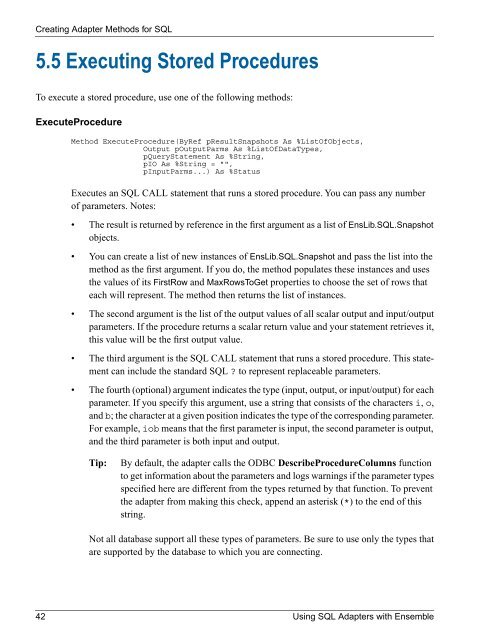Using SQL Adapters with Ensemble - InterSystems Documentation
Using SQL Adapters with Ensemble - InterSystems Documentation
Using SQL Adapters with Ensemble - InterSystems Documentation
Create successful ePaper yourself
Turn your PDF publications into a flip-book with our unique Google optimized e-Paper software.
Creating Adapter Methods for <strong>SQL</strong>5.5 Executing Stored ProceduresTo execute a stored procedure, use one of the following methods:ExecuteProcedureMethod ExecuteProcedure(ByRef pResultSnapshots As %ListOfObjects,Output pOutputParms As %ListOfDataTypes,pQueryStatement As %String,pIO As %String = "",pInputParms...) As %StatusExecutes an <strong>SQL</strong> CALL statement that runs a stored procedure. You can pass any numberof parameters. Notes:• The result is returned by reference in the first argument as a list of EnsLib.<strong>SQL</strong>.Snapshotobjects.• You can create a list of new instances of EnsLib.<strong>SQL</strong>.Snapshot and pass the list into themethod as the first argument. If you do, the method populates these instances and usesthe values of its FirstRow and MaxRowsToGet properties to choose the set of rows thateach will represent. The method then returns the list of instances.• The second argument is the list of the output values of all scalar output and input/outputparameters. If the procedure returns a scalar return value and your statement retrieves it,this value will be the first output value.• The third argument is the <strong>SQL</strong> CALL statement that runs a stored procedure. This statementcan include the standard <strong>SQL</strong> ? to represent replaceable parameters.• The fourth (optional) argument indicates the type (input, output, or input/output) for eachparameter. If you specify this argument, use a string that consists of the characters i, o,and b; the character at a given position indicates the type of the corresponding parameter.For example, iob means that the first parameter is input, the second parameter is output,and the third parameter is both input and output.Tip:By default, the adapter calls the ODBC DescribeProcedureColumns functionto get information about the parameters and logs warnings if the parameter typesspecified here are different from the types returned by that function. To preventthe adapter from making this check, append an asterisk (*) to the end of thisstring.Not all database support all these types of parameters. Be sure to use only the types thatare supported by the database to which you are connecting.42 <strong>Using</strong> <strong>SQL</strong> <strong>Adapters</strong> <strong>with</strong> <strong>Ensemble</strong>
















